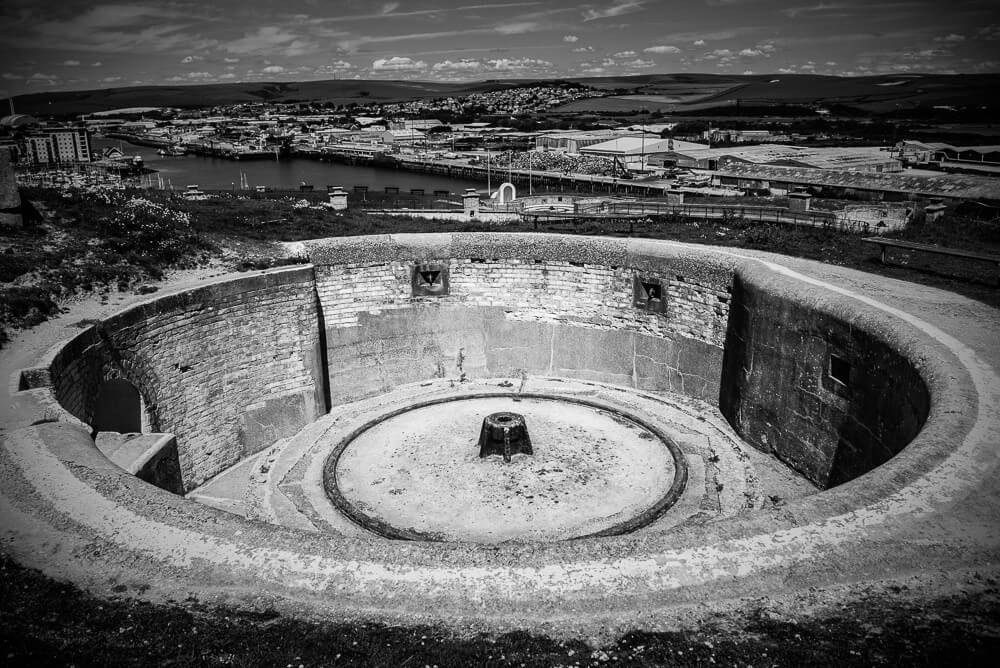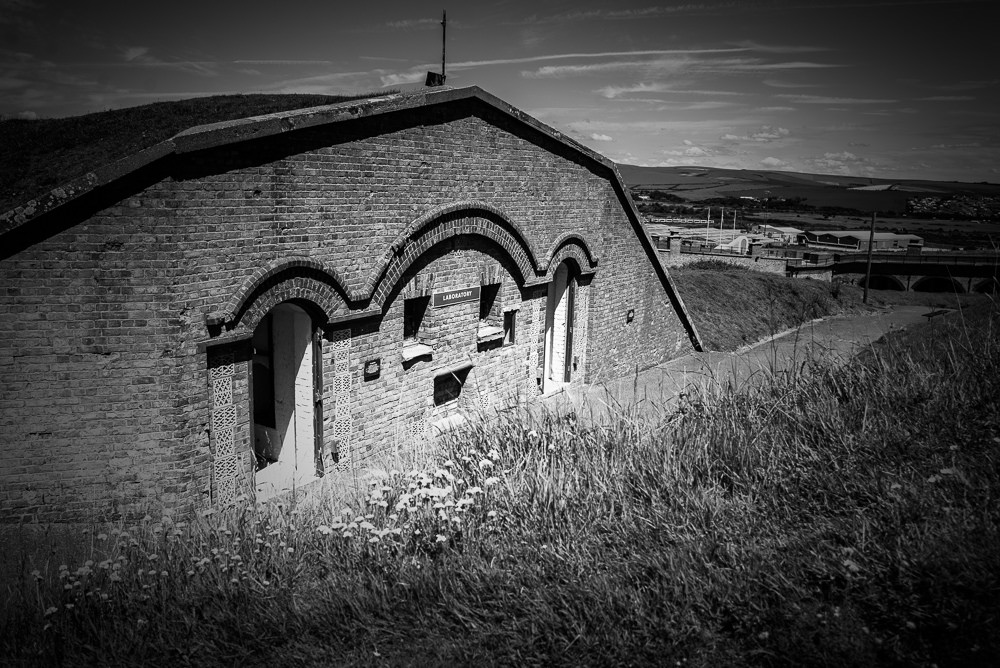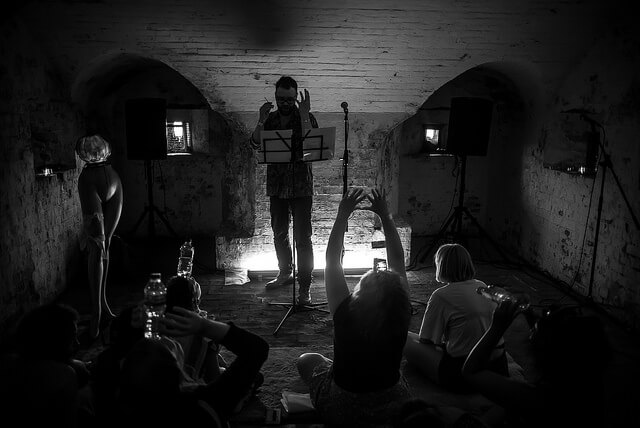Interview by Meritxell Rosell

Fort Process, the one-day multidisciplinary experimental sound and art festival, is back on the 22nd of September for its third edition next month. With the almost complete line-up at the moment, attendees can expect a day full of music performances, talks and installations challenging demanding ears with some of the most unconventional sonic and visual art.
Taking place in new haven Fort in Sussex and organised and curated by Lost Property – an association of artists, event organisers and publishers that have been promoting experimental sound and art in the south-east coast of the UK-, the event is articulated in a way that creates interactions between the acoustic and physical properties of that space.
The experience of Fort Process takes festival-goers wandering through underground tunnels, caverns and old armaments rooms, coming across new immersive artworks as they go before emerging into the sunshine. Musicians perform on old gun emplacements high up on the fort’s ramparts while the audience looks out to sea, and the many rooms in the fort grounds are host to talks and workshops.
This year they have invited artists to interpret the theme of science, and the programme presents both emerging and established individuals and groups working in the fields of experimental and improvised music, sound art, contemporary composition and performance art.
The Lost Property team have also launched a crowdfunding for Fort Process to give an extra push and make the festival even more special. We had a chat with four of its organisers – Geoff Reader, Graham Newbury, Daniel Mackenzie and Alistair Strachan, discussing the origins of the festival, the role of acoustics and spacial characteristic of the fort, the interest in scientific processes and experimentation, and where do they see taking Fort Process forward.



For our audience that is not familiar with your work, could you tell us a bit about your background, lost property and how and when the idea of Fort Process comes about?
Geoff Reader: The idea came up in 2012 when East Sussex County Council announced they were going to privatise the running of Newhaven Fort. Concerned that the character of the place might soon be lost, local book publisher Al Kemp got in touch with Graham Newbury, saying that something should be done in the space.
Graham Newbury: Graham and Al put together a working group made up of the organisers from regular Brighton-based experimental music events such as Splitting The Atom, Spirit of Gravity, Safehouse, plus the Coach House and individual sound artists. This became the production team for the first Fort Process.
Alistair Strachan: Plans escalated quickly as we realised the extraordinary potential of the site and the opportunity to do something very different there. We applied for Arts Council funding for the first time and got it – that felt like a big gear shift as suddenly we were able to invite artists from overseas and create our own site-specific installations in a way that hadn’t been possible before.
Graham Newbury: It was such a success and a good working group, so we decided to become Lost Property Arts Collective and eventually registered as a non-profit CIC.
Daniel Mackenzie: From there, we continued organising events: retrospectives of the work of Terry Riley and Alvin Lucier, a film season about hidden sound cultures across the world, and a Dada night at Cafe OTO that occurred 100 years to the day after the movement was established at Cabaret Voltaire. Two years after the first Fort Process festival, we did it again, and so it became a biannual event.
The location, Newhaven Fort, is a major player in the festival. How you do you articulate or think about the performances around it?
Geoff Reader: When Graham spoke to me about the idea I had already been to the fort with my children and had the first-hand experience of how great it sounded in itself. There are a lot of reverberant spaces, all different, from small hard-surfaced rooms to lengthy tunnels, lots of underground spaces. If you like sound, it’s an amazing place.
Graham Newbury: Our approach was always primarily about using the fort for site-specific works and sound art, with the performative side of FP being an equal part rather than becoming just another music festival.
Alistair Strachan: The response we got back from the first FP showed us that the experience of roaming around the fort was a big part of the appeal – it’s a bit like the illicit thrill you get from a late-night walkabout in a disused building.
Daniel Mackenzie: The space allows for a more fluid categorisation of disciplines. On one hand, you have fairly strict, static installation work; on the other, there’s the more traditional festival performance arrangement: stages, schedules, and specific timings. We’re able to explore this wide middle where physical acoustic space can impact upon or influence performance, or a performer can be free to adapt to a much longer performance time or unconventional stage set-up. This flexibility was epitomised by Liminal in the first Fort Process. They had us place a 200kg bell at the end of a particularly reverberant (and apparently haunted) tunnel, and the bell was struck at specific times between midday and 4 pm.
Why the interest in science for this year’s edition? What is the intellectual process behind it?
Geoff Reader: One thing was that It’s 250 years since the birth of Joseph Fourier, whose work underlies analogue synthesis. Also, I’m a physicist by education, so I always have an interest in science.
Daniel Mackenzie: Science opens up so many investigative processes that can inform artists’ and performers’ work. In previous years the main thread of exploration at the festival is about the physical spaces and their sonic properties. This time we’re looking deeper. Louise Mackenzie will be working with microscopic lifeforms; Disinformation and Jason Hotchkiss create works that harness and sculpt electricity; Tetsuya Umeda uses familiar objects and elemental processes to examine his immediate surroundings.
Where do you see taking Fort Process into?
Daniel Mackenzie: This year’s expanded season has provided an insight into ways to spread Fort Process out over a longer period. It would be interesting to continue these developments and look at other ways to stretch the format.
Alistair Strachan: We’ve been looking at other forts along the coast, such as the Napoleonic Redoubt in Harwich, where I grew up.
Graham Newbury: We also see this as something we can template and take to other sites internationally – loads of incredible neglected spaces we could repurpose.
Daniel Mackenzie: We’ve spoken about the re-appropriation of spaces associated with the violence of war and how these can be reassigned for more positive futures: providing an environment where people can create and therefore connect, rather than celebrate a destructive past.
What would be your biggest programming/curating extravaganza?
Alistair Strachan: A couple of weeks after the last Fort Process in 2016, we took off to Finland to visit the fortress of Suomenlinna, an island off Helsinki. We were shown around by Tina and Marie of the governing body there, as they were interested in what we had done at Newhaven and what we might do at Suomenlinna. We were all wowed by the place – from a disused aeroplane, and engineering works to hobbit-like structures built into the earth, myriad tunnels and craggy beaches – and made plans for an event that will hopefully materialise in the coming years.
Graham Newbury: Also, we have had positive meetings with various prime exponents in the arts sector of the coastal town of Ponta do Sol In Madeira about taking over the town and it’s many venues and art centres for a large arts festival, including wonderful long sound walks cut into the crags and under small waterfalls in the mountainous areas just off the coast, the possibility of a stage erected on the natural dam of an ancient riverbed and even a huge unfinished road tunnel cut into a mountain for use as a performance space.
Daniel Mackenzie: Something that genuinely had people wondering what it was they were experiencing. Some odd mixture of installation, performance, LARPing, interactive and moving yet psychedelic and mind-expanding, on a large, integrated scale. Not sure what that would actually be, though.
What is your chief enemy of creativity?
Graham Newbury: The need to chase funding constantly.
Geoff Reader: The vast amounts of bureaucracy. Meetings.
Daniel Mackenzie: Having too much to create.
Alistair Strachan: I don’t think we have one, so maybe we should advertise that as a new position available in the organisation – CEC.
You couldn’t live without…
Geoff Reader: Meetings, it seems.
Graham Newbury: Atomic Coffee and a well-crafted shoehorn.
Daniel Mackenzie: Coffee and houmous. They provide fuel to the overworked creative sector.





